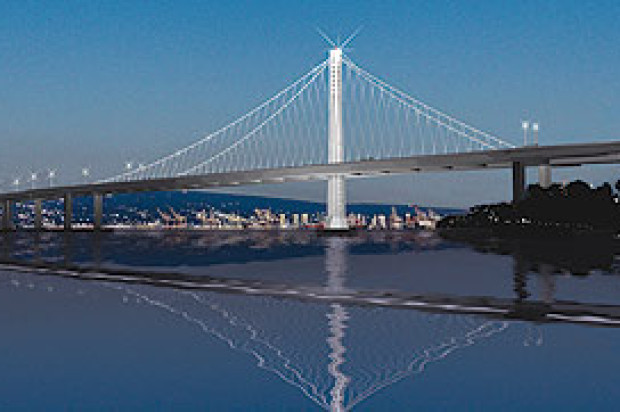
A Bay Bridge oversight committee approved funding today to begin designing methods of drying and sealing anchor rods in the base of the new eastern tower that have been steeping in bay water because a contractor failed to grout them properly.
The Toll Bridge Program Oversight Committee approved $1.1 million in funding at its meeting today for new design work and equipment, bringing the total tally for work on the problem to nearly $4.3 million.
What the final cost will be remains unclear and depends on recommendations from a panel of experts convened last month to study to what extent the rods have been damaged and how to best address the issue.
About a quarter of the 424 rods in the base of the 525-foot tower were confirmed this year to have been sitting in standing bay water because a contractor failed to adequately grout the steel tubes surrounding them.
The roughly 25-foot-long rods are designed to keep the tower from sliding on its concrete and steel foundation during an earthquake.
Bridge project chief engineer Brian Maroney reiterated today that the bridge as constructed is safe and the rods only come into play in the event of a major earthquake. The rods currently are performing as designed — 99 percent passed pull testing conducted earlier this year — what’s at stake is how long they will last.
“If we had a big earthquake this afternoon, the bridge at that location would perform exactly as it was supposed to,” Maroney said. The experts studying potential water damage to the rods are concentrating on making sure the bridge can last for 150 years.
Three rods removed from the tower since the bridge opened in 2013 were revealed through examination with an electron microscope to have microscopic factures. A fourth rod had no fractures but threads on it had been stripped.
Experts with the bridge project are still conducting testing to find out exactly why they failed, whether it was related to the water leakage, and whether more rods can be expected to break.
The $1.1 million approved today includes $500,000 for the design of a dehumidifier to dry the rods, $250,000 to find a protection system such as grease to prevent water from reaching the rods once they’re dry, $100,000 to purchase jacks to facilitate cleaning the rods and $250,000 for further testing on the removed rods.
The panel of experts unanimously agreed that those were the first necessary steps in dealing with the problem. They will reconvene later this month to discuss future steps.
Maroney said the rods may not even be ultimately necessary for the bridge to withstand a major earthquake — they are just one of numerous seismic safety measures built into the $6.4 billion project.
“This may not be anywhere near as big of a problem as some people have made it out to be,” Maroney said. He said the experts would decide how critical the rods are to the bridge and how much they might be damaged.
But committee chair Steve Heminger cautioned Maroney against that argument, saying that the steep cost of the bridge was supposed to include the full performance of each safety measure.
“The fact is, we paid for this extra level of performance,” Heminger said.
Another complication in determining the cause and extent of the damage to the rods is sorting through 158 boxes of hard copy records and almost 37,000 electronic records related to the project.
Some of the records relating to the initial construction of the rods have been difficult to locate, but the experts on the panel hope those records could glean new insight into at what point water started seeping into the steel tubes surrounding the rods.
The panel of experts is expected to issue a full report on problems with the bridge later this year.
Scott Morris, Bay City News









